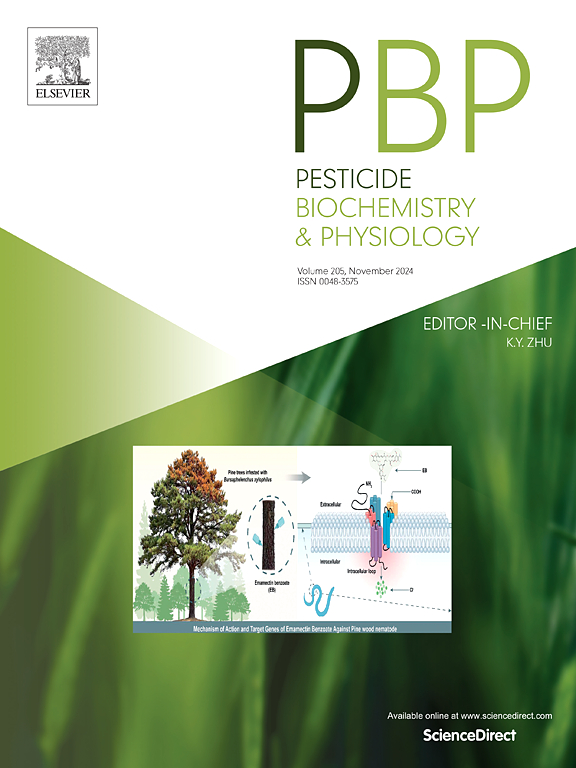饲粮中添加干酪乳杆菌可通过调节TLR4/NF-κB和AKT/Nrf2通路:氧化应激、炎症和铁下垂减轻氯菊酯暴露诱导的斑马鱼睾丸损伤
IF 4.2
1区 农林科学
Q2 BIOCHEMISTRY & MOLECULAR BIOLOGY
引用次数: 0
摘要
氯菊酯(Per)的广泛使用对水生生态系统构成重大风险,特别是通过生殖毒性。本研究探讨了干酪乳杆菌(Lactobacillus casei)对斑马鱼(Danio rerio)睾丸损伤的保护作用,并阐明了其潜在的分子机制。将雄性斑马鱼暴露于环境相关浓度的Per (1 μg/L)中,并添加不同剂量的干酪乳杆菌(107 ~ 109 CFU/g)或热杀对照30 d。结果表明,Per暴露抑制了生长参数,破坏了性激素稳态,诱导了睾丸组织病理学病变,包括生精小管紊乱和精子密度降低。在机制上,Per通过TLR4/NF-κB信号传导诱导氧化应激和激活炎症级联反应(IL-1β、IL-6、TNF-α上调),同时抑制AKT/ nrf2介导的抗氧化反应。值得注意的是,Per暴露促进铁下垂,证明了Fe2+积累和GPX4/SLC7A11下调。膳食中添加干酪乳杆菌(108 CFU/g最佳剂量)可剂量依赖性地逆转这些效应,恢复氧化还原平衡,减轻炎症并重新激活nrf2驱动的抗氧化防御。转录组学分析显示,干酪乳杆菌调节了3732个差异表达基因,主要在TLR4/NF-κB和PI3K-AKT通路中。药理学验证证实,干酪乳杆菌的保护作用基于双重调控:TLR4抑制(通过TAK-242)消除了抗炎作用,AKT激活(通过SC79)增加了Nrf2的表达。关键是,热杀灭干酪乳杆菌未能减弱Per毒性,这突出了对活菌的需求。本研究提供了新的证据,表明干酪乳杆菌通过TLR4/NF-κB失活和AKT/Nrf2通路激活,协同抑制氧化炎症和铁凋亡,减轻了per诱导的睾丸损伤。这些发现促进了水生毒理学中基于益生菌的干预策略。本文章由计算机程序翻译,如有差异,请以英文原文为准。
Dietary supplementation of Lactobacillus casei alleviates permethrin exposure-induced zebrafish testis damage through modulation of TLR4/NF-κB and AKT/Nrf2 pathways: Oxidative stress, inflammation and ferroptosis
The widespread use of permethrin (Per) poses significant risks to aquatic ecosystems, particularly through reproductive toxicity. This study investigated the protective effects of Lactobacillus casei (L. casei) against Per-induced testicular damage in zebrafish (Danio rerio) and elucidated the underlying molecular mechanisms. Male zebrafish were exposed to environmentally relevant concentrations of Per (1 μg/L) and supplemented with different doses of L. casei (107–109 CFU/g) or heat-killed controls for 30 days. Results showed that Per exposure suppressed growth parameters, disrupted sex hormone homeostasis and induced histopathological testicular lesions, including spermatogenic tubule disorganisation and reduced sperm density. Mechanistically, Per induced oxidative stress and activated inflammatory cascades (IL-1β, IL-6, TNF-α upregulation) via TLR4/NF-κB signaling, while suppressing AKT/Nrf2-mediated antioxidant responses. Notably, Per exposure promoted ferroptosis as evidenced by Fe2+ accumulation and GPX4/SLC7A11 downregulation.
Dietary L. casei supplementation (108 CFU/g optimal dose) dose-dependently reversed these effects, restoring redox balance, attenuating inflammation and reactivating Nrf2-driven antioxidant defences. Transcriptomic analysis revealed that L. casei modulated 3732 differentially expressed genes, predominantly in the TLR4/NF-κB and PI3K-AKT pathways. Pharmacological validation confirmed that L. casei protection was based on dual regulation: TLR4 inhibition (via TAK-242) abolished the anti-inflammatory effects, while AKT activation (via SC79) increased Nrf2 expression. Crucially, heat-killed L. casei failed to attenuate Per toxicity, highlighting the need for viable probiotics. This study provides novel evidence that L. casei alleviates Per-induced testicular injury through coordinated suppression of oxidative inflammation and ferroptosis, mediated by TLR4/NF-κB inactivation and AKT/Nrf2 pathway activation. These findings advance strategies for probiotic-based interventions in aquatic toxicology.
求助全文
通过发布文献求助,成功后即可免费获取论文全文。
去求助
来源期刊
CiteScore
7.00
自引率
8.50%
发文量
238
审稿时长
4.2 months
期刊介绍:
Pesticide Biochemistry and Physiology publishes original scientific articles pertaining to the mode of action of plant protection agents such as insecticides, fungicides, herbicides, and similar compounds, including nonlethal pest control agents, biosynthesis of pheromones, hormones, and plant resistance agents. Manuscripts may include a biochemical, physiological, or molecular study for an understanding of comparative toxicology or selective toxicity of both target and nontarget organisms. Particular interest will be given to studies on the molecular biology of pest control, toxicology, and pesticide resistance.
Research Areas Emphasized Include the Biochemistry and Physiology of:
• Comparative toxicity
• Mode of action
• Pathophysiology
• Plant growth regulators
• Resistance
• Other effects of pesticides on both parasites and hosts.

 求助内容:
求助内容: 应助结果提醒方式:
应助结果提醒方式:


